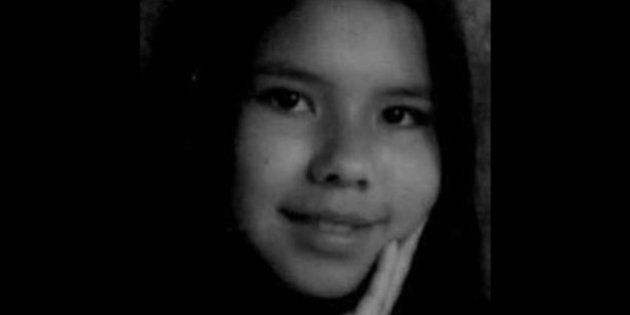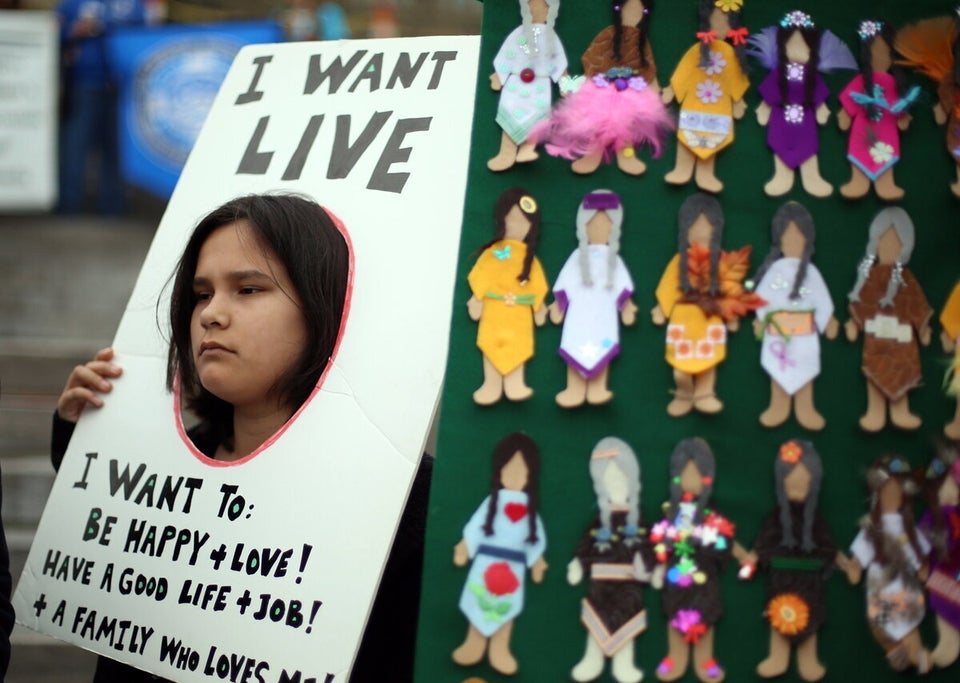
Across Canada, Saturday, October 4 was the National Day of Vigils to remember missing and murdered Aboriginal women and girls. That morning, the Globe and Mail marked the occasion with a column by National Affairs columnist Gary Mason comparing the disappearance of Tina Fontaine, the 15-year-old Anishinaabe girl found murdered in Winnipeg in August, with that of Alice Gross, a 14-year-old white girl whose disappearance in London, England prompted a stunning manhunt of over 600 police officers from a variety of different police organizations.
Mason is right to compare the searches for both girls -- the latter boasting a $36,000 reward and the largest manhunt in England since the 2005 terror attacks, and the former meriting only, as Mason puts it, "a perfunctory release alerting the public to her disappearance." Surely, one senses Mason implying, each girl's disappearance should have merited a massive manhunt. Surely, then, the indifference to Fontaine's fate says something about us all.
Reading his sensible contrast between difference in institutional responses to the disappearances of a wealthy white girl and a poor Aboriginal girl, it's hard not to reflect on Mason's flat dismissal last month of demands for an inquiry into missing and murdered Aboriginal women ("Are native leaders ready to be part of the solution?" August 29). In that column, Mason argued that we couldn't benefit from an inquiry, because we apparently know why Aboriginal women and girls go missing and get murdered:
"There are thousands of young aboriginal women living in situations not dissimilar to the one where Tina found herself," he says. "They stay with relatives because their parents, struggling with addiction and other issues, are unable to care for them. Some are physically or sexually abused. For many, a life on the streets is better than the one they have at home."
On the street, he concludes, girls are more likely to be murdered, but Mason doesn't expand this thought further. Instead, he shifts into a discussion of the findings of B.C.'s provincial Representative for Children and Youth, Mary Ellen Turpel-Lafond. Last year, Turpel-Lafond released "When Talk Trumped Service: A Decade of Lost Opportunity for Aboriginal Children and Youth in B.C.," a damning report that noted that B.C.'s Ministry of Children and Family Development spent $66-million on bureaucratic activities, such as discussions about regional Aboriginal authorities.
For Mason, Turpel-Lafond's report on misdirected funding is the end of the argument about missing and murdered women, a subject to which the report itself bears only tangential relation. "Nearly $66-million of federal and provincial funding [went] to aboriginal child-welfare authorities without a single penny of it going to help children," he cries, flush with proof that some Aboriginal politicians and bureaucrats have wasted money, before winding into an argument not dissimilar from the usual assumptions that First Nations people are lazy, corrupt, selfish, and always demanding some kind of handout.
For Mason, fiscal mismanagement of child-welfare funds by Aboriginal authorities plays a much greater role in the disappearance or murder of over 1,100 Aboriginal women than trauma inflicted on every Indigenous community in Canada by what Mason charitably -- and repulsively -- calls "the residential schools experiment." There's little talk of the way quiet racial assumptions might influence police investigations, or of the structure of police departments operating in areas with high Indigenous populations. Even in his more recent column about Tina Fontaine, Mason is quick to absolve the Winnipeg police, saying their "overworked, seven-officer missing persons unit did what it could."
Certainly, to Mason, systemic racism in non-Aboriginal communities making it more difficult for Aboriginal people to get jobs and be promoted or to find affordable housing off-reserve isn't a key issue when it comes to the problem of missing and murdered women. Neither, of course, could the issue be racism at the federal government level that has resulted in the unconscionable shortage of on-reserve housing, cramming families together in toxic buildings that AANDC isn't in any hurry to replace.
In spite of making child welfare a central plank of his argument, Mason doesn't consider the fact that First Nations Child and Family Services Executive Director Cindy Blackstock is presently challenging the government of Canada in a Human Rights Tribunal over chronic underfunding of on-reserve child welfare--leaving Aboriginal kids across Canada with as much as 20% less of the funding their non-Indigenous counterparts receive. That stuff, to Mason, seems too vague to have any power over whether Aboriginal women get murdered.
"The hard truth about today's debate around missing and murdered aboriginal women," Mason says, "is this: Nothing will be done to address this matter until aboriginal leaders own some of the responsibility themselves. For too long now, they have pointed the fingers at everyone else and refused to be held accountable. It's the province's fault. It's Ottawa's fault. It's the fault of everyone but First Nations themselves."
Putting aside the shrill racism of the assumption that "Aboriginal leaders," generally, agree on anything at all, and that none has borne responsibility for failures in his or her community leading to issues such as increased family violence, addiction, or homelessness, it's still stunning that Mason can miss the central problem of missing and murdered women: the notion that the women themselves have little value to those around them.
There is no question that in many Aboriginal communities across Canada, there are problems with substance abuse and family violence. A quick review of Canadian history leads to the unfortunate conclusion that stealing Native children, beating their languages and cultures out of them for years, often raping and torturing them for good measure, and dumping them back in the communities you worked hard to teach them were worthless is probably a good way to promote a high degree of violence and addiction.
This is, as Mason puts it, "the hard truth." It is very hard and very shameful to admit that for well over 100 years, our country engaged in a quiet genocide (defined according to Article 2, parts b, c, e, and sometimes d, of the UN's Convention on Genocide) against Aboriginal people through the Indian Residential Schools system. When it finally closed the schools, our country didn't do nearly enough (or, for that matter, very much at all) to attempt to right the enormous wrong of their having existed for so long. That wrong lives on in suffering communities from coast to coast to coast, and it's not hard to understand why even if it's hard for some to accept. On reflection of our official history of destroying Aboriginal people and families, it's tough not to notice that what the government of Canada was doing was driving into those children what so many of us already believed then and still believe now: that Native lives don't matter.
Within their communities, at least, the women who go missing have some value -- that's why Indigenous Nations across Canada have been sounding the alarm over the missing women for years. The real problem is outside of Native communities, where 1,000 missing and murdered women don't add up to the panic Mason profiles over a single missing white girl.
In Tina Fontaine's case -- or in the cases of the many women killed by Robert Pickton -- the killer knew enough to wager that the community wouldn't notice another missing Aboriginal woman. He understood that Aboriginal women don't have a lot of value in Canadian society -- nor do the extremely poor, the drug- or alcohol-addicted, and those who sell sex. So an impoverished Aboriginal girl impaired by drugs or alcohol, willing to accept money or a place to stay in exchange for sex? Who would care if they learned one of those people went missing?
That last question is the one that Gary Mason should have been trying to answer: how do we make police, governments, institutions, and one another care more about Aboriginal women, even if they do things that some among us may find unseemly, like drinking or using drugs or selling sex?
This is precisely the question that those demanding an inquiry into missing and murdered women hope to see answered. Because it's become excruciatingly obvious in Canada that men -- sometimes Aboriginal men, often white men -- can kill Aboriginal women with virtual impunity, and that is not the fault of Aboriginal women, nor the fault of the leaders of the Aboriginal communities they come from. The murders, of course, are the fault of the killers. But the fact that we have such a hard time noticing it happening, let alone bringing the killers to justice, that's someone else's fault, and an inquiry would help us identify the culprits and, hopefully, stem this epidemic. Not just the epidemic of murder, but the epidemic of seeing Indigenous women as worthless.
The post originally appeared, in a longer form, on the website of the Nation magazine.
ALSO ON HUFFPOST:
